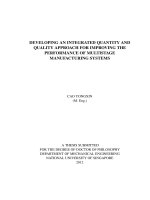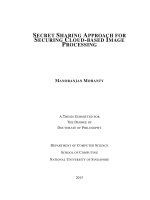- Trang chủ >>
- Sư phạm >>
- Sư phạm hóa
working method approach for introductory physical chemistry calculations (RSC, 1997)(0854045538)
Bạn đang xem bản rút gọn của tài liệu. Xem và tải ngay bản đầy đủ của tài liệu tại đây (6.43 MB, 168 trang )
A WORKING METHOD APPROACH FOR INTRODUCTORY
PHYSICAL CHEMISTRY CALCULATIONS
Numerical and Graphical Problem Solving
RSC Paperbacks
RSC
Paperbacks are a series of inexpensive texts suitable for teachers and
students and give a clear, readable introduction to selected topics in chemistry.
They should also appeal to the general chemist.
For
further information on
available titles contact:
Sales and Promotion Department
The Royal Society of Chemistry
Thomas Graham House
Science Park, Milton Road
Cambridge
CB4
4WF,
UK
New Titles Available
Archaeological Chemistry
by
A.
M. Pollard and
C.
Heron
Food
-
The Chemistry of Its Components (Third Edition)
by
T.
P.
Coultate
The Chemistry of Paper
by J.
C.
Roberts
Introduction to Glass Science and Technology
by James
E.
Shelby
Food
Flavours:
Biology and Chemistry
by Carolyn
L.
Fisher and Thomas
R.
Scott
Adhesion Science
by J. Comyn
The Chemistry of Polymers (Second Edition)
by John
W.
Nicholson
A
Working Method Approach for Introductory Physical Chemistry Calculations
by Brian Murphy, Clair Murphy and Brian Hathaway
How
to
Obtain RSC Paperbacks
Existing titles may be obtained from the address below. Future titles may be
obtained immediately on publication by placing a standing order for RSC
Paperbacks. All orders should be addressed to:
The Royal Society of Chemistry
Turpin Distribution Services Ltd.
Blackhorse Road
Letchworth
Herts:
SG6
lHN, UK
Telephone:
+
44
(0)
1462 672555
Fax:
+
44
(0)
1462 480947
RSC
Paperbacks
A WORKING METHOD APPROACH
FOR
INTRODUCTORY PHYSICAL
CHEMISTRY CALCULATIONS
Numerical and Graphical Problem Solving
BRIAN
MURPHY',
CLAIR
MURPHY~
AND
BRIAN HATHAWAY2
Department
of
Chemistry
University
of
Wales, Cardiff,
UK,
and
2Department
of
Chemistry,
University College Cork, Ireland
em-
&&
THE
ROYAL
SOCIETY
OF
CHEMISTRY
Information
Services
ISBN
0-85404-553-8
A
catalogue record for this book is available from the British Library
0
The Royal Society of Chemistry
1997
All rights reserved.
Apart from any fair dealing for the purposes
of
research or private study, or criticism or
review
as
permitted under the terms
of
the
UK
Copyright, Designs and Patents Act,
1988,
this publication may not be reproduced, stored or transmitted,
in
any form or by any
mew, without the prior permission
in
writing
of
The Royal Society
of
Chemistry, or in the
case
of
reprographic reproduction only in accordance with the terms
of
the licences issued
by the Copyright Licensing Agency in the
UK,
or
in
accordance with the terms
of
the
licences issued by the appropriate Reproduction Rights Organization outside the
UK.
Enquiries concerning reproduction outside the terms stated here should be sent
to
The
Royal Society
of
Chemhtry
at
the address printed on this page.
Published by The Royal Society of Chemistry, Thomas Graham House, Science Park,
Milton Road, Cambridge
CB4
4WF,
UK
Typeset by Computape (Pickering) Ltd, Pickering, North Yorkshire,
UK
Printed by Athenaeum Press Ltd, Gateshead, Tyne and Wear,
UK
Preface
The basis of physical chemistry is the ability to solve numerical
problems. It is generally agreed that it is not with inorganic and
organic chemistry that first-year and preliminary-year undergraduate
students have the greatest difficulty, but instead the numerical
problem-solving aspect of physical chemistry. The global trend of
below-average marks in physical chemistry in first-year and preli-
minary-year chemistry papers needs to be addressed.
The preparation of textbooks has been made much easier by the
improvements in the technology of book production. This has resulted
in the production of much more colourfully attractive textbooks of
general and introductory chemistry. This would not be a problem if
the basic principles of chemistry were still clearly identifiable. Un-
fortunately, often this is not the case and the principles, even when
well described, are lost beneath a wealth of factually unconnected
data, that is unnecessary for the student to learn.
This is particularly apparent in the sections on basic introductory
physical chemistry. Although many of these
1
000-page textbooks
contain well-written individual chapters on thermochemistry, equili-
brium, electrochemistry and kinetics, with attractive diagrams, the
fundamentals are sometimes lost in a sea of historical facts.
No
connectivity between the chapters is introduced and the impression
is that each subject is divorced from the other sections. What is
more disturbing is that although numerical problems and solutions
do appear in such textbooks, no logical stepwise procedure is
presented, leaving the student totally isolated when faced with a
similar problem. Equally, the appearance of
60-70
numerical pro-
blems at the end of each chapter is unrealistic and inappropriate at
this level. This approach is fine in more advanced physical chemistry
textbooks, but such complexity and number of problems
is
not
vi
Preface
suitable
for a basic undergraduate introductory course on physical
chemistry!
The ability to solve numerical problems is the foundation of any
physical chemistry course. This text-book is dedicated to those first-
year and preliminary-year chemistry students who have not previously
taken A-level or Leaving Certificate chemistry, or any student who
finds major difficulty with physical chemistry problems at this level.
Sadly, the skill of numerical problem-solving is being relegated to a
bare nothing in secondary-level chemistry courses. The amount of
physical chemistry that is taught is progressively being eroded away in
schools, leaving first-year and preliminary-year chemistry students
facing a complete cultural shock when posed with the volume of
numerical problems which they must solve, on entrance to universities
and tertiary-level institutions. This worrying trend may account for
the poor first-year and preliminary-year examination results returned
in physical chemistry papers.
Current textbooks do little to identify and confront this problem. A
gentle systematic step-wise approach
of
a ‘Working Method’ is one
method
of
addressing this decline in marks and the difficulty that
students face with physical chemistry. Ironically, in many textbooks,
working methods are mentioned; however, these appear with great
infrequency. The aim of this textbook is to treat each numerical
problem in introductory physical chemistry with the systematic step-
wise approach
of
the ‘working method’. Students need to gain
confidence in tackling numerical problems and a systematic approach
can certainly help.
The text does not imply offering ‘recipes’for solving
such problems,
but
hopefully it will encourage students to think out their
own
approach.
We believe that if students can get started on such
problems, this approach will encourage the students to think for
themselves when faced with morz challenging problems. Equally, a
working method on graphical problems is presented, a rarity in
physical chemistry textbooks at this level, and yet essential in
so
many
other subjects in science, such
as
physics, biochemistry, nutrition,
geography, optometry, food science,
etc.;
undergraduate students of
these courses rely on a good basic chemistry course to develop such a
skill.
The present text tries to overcome the limitations
of
these texts,
by covering the basic principles of introductory physical chemistry
in a short and concise way. Each chapter contains an introduction,
followed by a typical examination question at the appropriate
level, and then takes the student stepwise through the working
method.
Preface
vii
This text is written against a series of computer-aided learning
(CAL) tutorials. These tutorials have been in use for the past four
years at University College Cork (UCC) (and more recently at the
University of Wales, Cardiff and Dublin City University), and are
extremely popular with the
300
students per year taking the course.
With such a back-up to the courseware, the main recommended
physical chemistry textbook, the large and small group tutorials and
the lecture course, the student should not feel
so
isolated with the
problems associated with physical chemistry.
The use of the CAL courseware in UCC is entirely optional and
supplementary to the normal teaching programme (namely, lectures,
practicals, large and small group tutorials), but the interactive
nature of the courseware, especially for numerical problem solving,
is very attractive to the students, particularly to those with a weak
chemistry background. As the courseware is based upon UCC-type
examination questions and also reflects the UCC lecturer’s approach
to his teaching, the tutorials are not
100%
transferable to other
third-level institutions, but the physical chemistry tutorials are avail-
able from the authors to illustrate the approach taken in writing
the courseware and are available free of charge on the Internet
at
URL:
http://www .cf. ac. uk/uwcc/chem y/murphybm/bm
1.
html. This
generally follows the approach of the individual chapters in the
present text and, in any case, the authors firmly believe that the
best
courseware should be written in-house, to best reflect the approach
of the course lecturer involved.
One final point. This text is based on the current first-year science
chemistry course of a four-year B.Sc. degree course taken at Uni-
versity College Cork. The majority of students taking this course are
non-intending chemists. Although the text covers most of the main
areas of a typical general chemistry course, the authors
do
not
claim
in
any way that this material is the most appropriate for such
a
course;
indeed, many universities may include topics such as spectroscopy in
such
a
course, and may prefer to change the order of the subjects
taught. This, however, is
not
the purpose of this text. For example, the
two chapters on kinetics are relegated to the end of the text, as the
authors have found that students have trouble with some of the maths
in this section. Also, the two chapters on electrochemistry are slightly
expanded, since many students have expressed concern over the
presentation of such material in other texts.
So,
in conclusion, this text
is in many senses in response to the needs of the non-intending
chemistry students who have struggled for far too long in physical
chemistry at this level. However, it is hoped that lecturers and teachers
Vlll
Preface
will also find this a useful text, and will use this text as a basis for
encouraging students to think out problems for themselves, before
going on to more challenging problems!
Note: while every effort has been made to eliminate errors in this
book, inevitably some will have crept through. The authors would
appreciate notification by readers of any errors. They may be con-
tacted as follows:
Brian Hathaway: Tel.
353-21-902379
Fax
353-21-274097
e-mail ,ie
Brian Murphy: Tel.
353-1-7045000
Fax
3
53-1-7045503
Brian Murphy and Brian Hathaway
Contents
Chapter
1
Introduction to Physical Chemistry: Acids and Bases,’
Introduction
States
of
Matter
Acids and Bases
The Gas Laws
-
Idea of Proportionality
Kinetic Theory
of Gases
The General Gas Equation
Importance of Units in Physical Chemistry
A
General Working Method to Solve Numerical Problems
Working Method for Graphical Problems
Conclusion
Multiple-Choice Test
The
Gas
Laws, Numerical and Graphical Problem Solving
in Physical Chemistry
Chapter
2
Thermodynamics I: Internal Energy, Enthalpy, First Law
of
Introduction
Definition
of
Thermodynamics
-
Introducing the System
Internal Energy,
U
Enthalpy,
H
The First Law of Thermodynamics
State Functions
Hess’s Law
Worked Example Using the Working Method
of
Thermodynamics, State Functions, and Hess’s Law
and the Surroundings
Hess’s
Law
10
12
15
15
17
17
17
18
18
20
20
20
22
X
Contents
Chapter
3
Thermodynamics
11:
Enthalpy, Heat Capacity, Entropy, the
Second and Third Laws
of
Thermodynamics and Gibbs
Free
Energy
Introduction
Enthalpy,
H
Heat Capacity
Entropy,
S,
and Change in Entropy,
AS
Gibbs Free Energy,
G,
and Change in Gibbs
Working Method for the Calculation of
AG
Type Problems
Worked Example
Summary of Chapters
2
and
3
on Chemical
Thermodynamics
Multiple-Choice Test
Long Questions
on
Chapters
2
and
3
Free Energy,
AG
Chapter
4
Equilibrium I: Introduction to Equilibrium and
Le
Chstelier’s
Principle
Introduction
The Law of Chemical Equilibrium
Working Method for the Solution
of Standard Equilibrium
Examples
Relationship between
AG
and
Kp
Le
Chiitelier’s Principle
Summary
Type Problems
Chapter
5
Equilibrium
11:
Aqueous Solution Equilibria
Acids and Bases
Common Ion Effect
Dissociation
of
H20 and pH
Hydrolysis
Buffer Solutions
Advanced Equilibrium Problems
-
Working Method
Polyprotic Acids
Solubility Product
Summary
Multiple-Choice Test
Long Questions on Chapters
4
and
5
24
24
24
27
29
31
33
34
34
34
35
36
36
37
40
42
44
44
46
47
47
48
50
52
53
55
59
59
60
61
62
Con
tents
xi
Chapter
6
Electrochemistry
I:
Galvanic Cells.
Introduction to Electrochemistry
Redox Reactions
-
Revision
Galvanic Cells
Working Method for Galvanic Cell Problems
Chapter
7
Electrochemistry
11:
Electrolytic Cells
Electrolysis
Types of Electrolytic Cells
Examples
of
Electrolytic Cell Type Problems
Summary
Multiple-choice Test
Long
Questions on Chapters
6
and
7
Chapter
8
Chemical Kinetics
I:
Basic Kinetic Laws
Rate
of
a Reaction
Rate Law
Order of a Reaction
Half-Life
Examples
Determination
of
the Order of a Reaction
Working Method for the Determination of the Order
of
a
Reaction by the Method of Initial Rates
How Concentration Dependence,
i.e.
the Order
of
a
Reaction, Can be Used to Develop a Mechanism for a
Reaction
Summary
Chapter
9
Chemical
Kinetics
11:
The Arrhenius
Equation and Graphical
Problems
Moleculari ty
The Activation Energy
of
a Reaction
The Arrhenius Equation
Working Method for the Solution of Graphical Problems in
Worked Examples
Rate Constants and Temperature
Kine tics
63
63
65
67
78
89
89
97
1 04
110
110
111
113
113
114
115
118
1 20
121
122
125
127
128
128
129
130
133
136
139
xii
Con tents
Summary
of
the Two Chapters on Chemical Kinetics
Multiple-Choice Test
Long Questions on Chapters
8
and
9
Answers to Problem
Further Reading
Periodic Table
of
the Elements
Subject Index
142
142
143
145
147
148
149
Acknowledgements
The authors wish to acknowledge Dr Ross Stickland, Physical Chem-
istry Section, Department of Chemistry, University of Wales, Cardiff
and Gillian Murphy, Department of Chemistry, University of Cork,
for proof-reading this text. The following are also acknowledged for
useful suggestions and continued support: Professor Wyn Roberts,
Head
of
Department, University
of
Wales, Cardiff, Dr Gary Attard,
Dr Eryl Owen, Physical Chemistry Section, and Professor Michael
B.
Hursthouse, Structural Chemistry, Department of Chemistry, Univer-
sity
of
Wales, Cardiff.
Chapter
I
Solid, Liquid and
Gas
Introduction to Physical Chemistry:
Acids and Bases, The Gas Laws and
Numerical and Graphical Problem
Solving
State
Conditions
INTRODUCTION
This chapter is a brief introduction to many of the assumptions made
in the remainder of this text and the basis
of
physical chemistry type
problems. The spider diagram of Figure
1.1
illustrates the various
sections.
Figure
1.1
Summary
of
the contents
of
Chapter
I
2
Chapter
1
STATES
OF
MATTER
Mutter
is the chemical term for materials. There are three states
of
matter: the solid phase (s), the liquid phase (1) and the gaseous phase
(g). In the solid phase, all the atoms or molecules are arranged in a
highly ordered manner [Figure 1,2(a)], whereas in the liquid phase
[Figure 1.2(b)], this ordered structure is not as evident. In the gaseous
phase [Figure 1.2(c)), all the particles are moving at high velocity, in
random motion. The disorder or entropy,
S,
is at its maximum in the
gaseous phase [Figure 1.2(c)].
(a)
Solid
(s)
(b)
Liquid
(1)
(c)
Gas
(g)
Increasing
disorder or entropy,
S
Figure
1.2
States
of
matter-solid, liquid and gas
If
a species is dissolved in water, it is said to be in the aqueous
phase (aq), and the symbol can be represented as a subscript,
e.g.
HCl(aq)*
ACIDS AND BASES
An
acid
is a proton (H+) donor and a base
is
a proton acceptor,
e.g.
(OH-). Examples
of
acids include HCl, H2SO4, HN03, HCN and
CH3C02H. A
monoprotic
acid is an acid with one replaceable proton,
e.g.
HCl
(eA
=
1); a
diprotic
acid is an acid with two replaceable
protons
e.g.
H2SO4
(eA
=
2)
etc.,
where
eA
is the number of reactive
species. A
dilute
acid is an acid which contains a small amount
of
acid
dissolved in a large quantity
of
water, whereas a
concentrated
acid is
an acid which contains a large amount
of
acid dissolved in a small
quantity of water.
Examples
of
bases include NaOH
(eB
=
l),
KOH
(eB
=
l),
Ba(OH)2
(eB
=
2), Ca(OH)2
(eB
=
2),
Mg(OH)2
(eB
=
2),
Na2C03
(eB
=
2),
NH3
and CH3NH2, where
eB
is the number
of
reactive
Introduction to Physical Chemistry
3
species.
e.g.
OH
An acid combines with a base to form a salt and
water:
I
i.e.
ACID
+
BASE
-+
SALT
+
WATER^
e.g.
HN03
+
NaOH
-+
NaN03
+
H20
In general, an acid can be represented as HA, where
HA
-+
H+
+
A- or,
more precisely,
HA
+
H20
-+
A-
+
H30+,
since all aqueous protons are solvated by water. Likewise, a base
containing hydroxide anions, OH-, can be represented as MOH,
where
MOH
$
M+
+
OH
When an acid donates a proton,
H+
,
it is said to form the
conjugate
base
of the acid,
i.e.
HA (acid)
*
H+
+
A- (conjugate base). The
conjugate base is a base since it can accept a proton to reform HA, the
acid. Similarly, when a base accepts a proton, H+
,
the
conjugate acid
of the base is said to be formed,
i.e.
B
(base)
+
H+
HB+
(conjugate acid). The conjugate acid is an acid since it can donate a
proton,
H+
,
and reform the base,
e.g.
NH4+ (conjugate acid)
+
NH3
(base)
+
H+.
Ions,
Cations,
Anions,
Oxyanions and Oxyacids
Ions
are charged species,
e.g.
Na+, Cl-, NH4+
etc.
Cations
are
positively charged ions,
e.g.
Na+, NH4+, Mg2+,
H30+
etc.
Anions
are negatively charged species,
e.g.
OH-,
C1-,
02-
etc.
A useful
way
of
remembering this is the two n’s,
i.e.
anion
=
negatively
charged ion! An
oxymion,
as its name suggests, is an anion
containing oxygen,
e.g.
NO,,
SO:-
etc.
An
oxyacid
is the corre-
sponding acid of the oxyanion,
e.g.
HN03 and H2SO4 are the
oxyacids of the nitrate and sulfate oxyanions respectively. The
oxidation state or oxidation number of the nitrogen, Nv and the
sulfur,
Svl,
is the same in both the oxyacid and the oxyanion. Table
1.1
is a summary of some
of
the common oxyanions and their
corresponding oxyacids.
4
Chapter
I
Table
1.1
Summary
of
some
of
the common oxyanions, the corre-
sponding oxyacidr, charges, oxidation numbers and the
number
of
replaceable hydrogens
Charge Oxyanion Oxyacid eA
-1
-1
-2
-2
-3
-3
-1
-1
-2
N"'0; (Nitrite)
NVOi (Nitrate)
~'~0:-
(Sulfi te)
~~'0:-
(sulfate)
PI"0:- (Phosphite)
PvO!- (Phosphate)
ClvOy (Chlorate)
Clv"O;(Perchlorate)
CIvO;-(Carbonate)
H N1"02 (Nitrous acid)
1
H Nv03 (Nitric acid)
1
H2StV03 (Sulfurous acid)
2
H2SV104 (Sulfuric acid)
2
H3p11103 (Phosphorous acid)
3
HgV04 (Phosphoric acid)
3
HClV03 (Chloric acid)
1
HClV"04 (Perchloric acid)
1
H2CIV03 (Carbonic acid)
2
THE
GAS LAWS-IDEA
OF
PROPORTIONALITY
Boyle's
Law
Pressure
is defined as the force acting on a unit area,
i.e.
p
=
F/A.
The
unit
of
pressure is the newton per square metre,
N
m-'
or the Pascal,
Pa.
At
sea level, the pressure due to the weight
of
the earth's atmo-
sphere
is
approximately
lo5
Pa. The bar, is often used as the unit
of
pressure in problems in physical chemistry, where
1
bar
=
lo5
N
m-'
or
lo5
Pa.
Consider the effect of a piston pressing down on a fixed mass of gas
of
initial pressure
Pinitial
and initial volume
Vinitial,
(Figure
1.3).
Figure
1.3
Application
of
pressure on a definite
mass
of
gas at constant
temperature
Introduction
to
Physical Chemistry
5
As
the pressure applied by the piston is increased, the volume
of
the
gas decreases
(i.e.
the space it occupies), if the temperature is kept
constant. This is Boyle’s Law
-
the volume of a definite mass
of
gas at
constant temperature is inversely proportional to its pressure.
i.e.
Boyle’s Law:
Voc
l/p
or
V
=
k/p,
where
k
is a constant
of
proportionality.
Example:
A
sample of gas
G
used in an air conditioner has a
volume of
350
dm3
and a pressure of
85
kPa at 25°C. Determine
the pressure
of
the gas at the same temperature when the volume is
500 dm3.
Solution:
The gas is at constant temperature, and therefore Boyle’s Law can be
applied:
Hence initially,
V1
=
k/pl
or
k
=
p1
V1
Hence
k
=
(85
kPa)
x
(350
dm3)
=
29750 kPa dm3
However finally,
p2
=
k/V2
=
29750/500
=
59.5
kPa
Answer
:
Final Pressure
=
59.5
kPa
Charles’s
Law
In contrast,
if
the pressure is kept constant, the volume
of
a definite
mass of gas will increase, if the temperature is raised. This is Charles’s
Law: the volume of a definite mass
of
gas at constant pressure
is
directly proportional to its temperature.
i.e.
Charles’s
Law:
V
oc
T
or
V
=
kT,
where
k
is
a different constant of
proportionality.
Example:
A
sample of gas
G
occupies 200 cm3 at
288
K
and
0.87
bar. Determine the volume the gas will occupy at
303
K
and at the
I
same pressure.
6
Chapter
I
Solution:
The gas is at constant pressure, and therefore Charles’s Law can be
applied:
Hence initially,
Vl
=
kT1
or
k
=
Vl/Tl
Hence
k
=
(200 m3)/(288
K)
NOW
V2
=
kT2,
SO,
V2
=
(0.694 cm3
K-’)
x
(303
K)
=
0.694 cm3
K-’
=
210.42cm3
Answer:
Final
Pressure
=
210.42
C&
Avogadro’s
Law
This states that equal volumes
of
gases, measured at the same
temperature and pressure, contain equal numbers
of
molecules.
i.e.
Avogadro’s Law:
V
a
n,
where
n
=
the amount of gas (measured
r
in moles).
The
mole
is defined as the amount of a substance which contains as
many elementary species as there are atoms in 12 g
of
the carbon-12
isotope.
A
mole contains 6.02205
x
particles, where
NA
is
defined
as
Avogadro’s
constant
i.e.
NA
=
6.02265
x
mol-’.
Ideal
Gases
An
ideal gas is a theoretical concept, a gas which obeys the gas laws
perfectly. If the three gas laws are combined, the resulting equation is
the equation
of
state
of
an
ideal gas:
(a) Boyle’s Law
:
V
oc
1
/p
(b) Charles’s Law
:
V
oc
T
(c) Avogadro’s Law
:
V
a
n
+pVanT
+
pV
=
knT,
(a),
(b)
and (4
=$
Va (TUP
where
k
is another constant
of
proportionality called the Universal
Gas Constant,
R.
[Zdeal Gas Equation:
pV
=
nRT
I
Introduction to Physical Chemistry
7
where
p
=
pressure
of
the gas (measured in bar);
V
=
volume
of
the gas
(measured in dm');
n
=
amount
of
gas (measured in mol);
T
=
temperature
of
the gas (measured in
IS);
R
=
Universal Gas Constant
=
0.08314 dm3 bar
K-'
mol-' (or 8.314
J
K-'
mol-I). The above
equation can also be modified to take into account changes in tempera-
ture,
AT,
changes in volume,
AV,
and changes in the coefficients
of
gaseous reagents,
Au,
respectively,
i.e.
pV
=
nRAT, pAV
=
nRT
and
pV
=
Au,RT.
ug
represents the coefficients in a chemical equation. For
example, in the reaction N2(g)
+
3H2(,
4
2NH3(g),
Aug
=
C[v(Gaseous products)]-C[u(Gaseous reactants)]
=
[(2)]
-
[(l)
+
(3)]
=
-2.
Molar
Volume
1
mole
of
an ideal gas measured at 25
"C
and 1 bar pressure occupies
24.8
dm3
(where
1
dm'
=
1000
cm3).
i.e.
1
mole
of
an ideal gas at 25 "C and
1
bar pressure occupies 24.8
1
dm3.
Example:
Calculate the amount
of
gas in moles in
2000
cm3
at
25 "C and 1 bar pressure.
Solution:
At 25
"C
and 1 bar pressure, 1 mole
of
an ideal gas occupies 24.8 dm3
1
dm3
=
(1/24.8) mol
i.e.
24.8 dm'
=
1
mol
2000cm'
=
2dm3
=
(2/24.8) mol
=
0.081 mol
Answer:
0.081
mol.
KINETIC
THEORY
OF
GASES
Kinetic energy is the energy a body possesses by virtue
of
its
motion. The molecules
of
gases travel at high velocity and hence
have high kinetic energy. The kinetic theory
of
gases
is
used to
explain the observed properties
of
gases,
of
which Brownian motion
provides good evidence.
Brownian motion
is the irregular zigzag
movement
of
very small particles suspended in a liquid
or
gas.
If
tobacco smoke is placed in a small cell, well-illuminated on a
microscope stage, the tiny particles appear to be moving at random,
as shown in Figure 1.2(c). This is due to the smaller invisible
8
Chapter
I
molecules of the air, colliding with the particles of the smoke. This
is Brownian motion.
The kinetic theory of gases is a model proposed to account for the
observed properties of gases. In order that the model is applicable,
certain assumptions are made.
For
this reason, gases are categorised
into two types: (a) ideal gases (as defined previously) and (b) real gases
(defined as non-ideal gases).
Assumptions
of
the Kinetic Theory
for
an
Ideal
Gas
1.
Gases consist of tiny molecules, which are
so
small and
so
far
apart that the actual size of the molecules
is
negligible in
comparison to the large distance between them.
2.
The molecules are totally independent of each other,
i.e.
there are
no attractive or repulsive forces between the molecules.
3.
The molecules are in constant random motion. They collide with
each other and with the walls or sides of the container, which
changes the direction
of
linear motion.
4.
For each elastic collision, there is no net loss of kinetic energy.
However, there may be transfer of energy between the particles
in such a collision.
5.
The average kinetic energy, of all the molecules is assumed to be
proportional to the absolute temperature
T
(measured in
K)
i.e.
kinetic energy
oc
T.
Validity
of
the Assumptions
of
the Kinetic Theory
for
an
Ideal
Gas
Assumption
I
This is largely true, since the compressibility of gases is
very high. However, at high pressures, when a gas is highly com-
pressed, it
is
not valid to state that the physical size
of
gas molecules is
practically negligible compared with the distances between the mole-
cules.
Assumption
2
This assumption is approximate, since gases diffuse or
spread out to occupy all space available to them,
i.e.
there must be no
appreciable binding force between the molecules. However, van der
Waals forces exist (intermolecular forces of attraction and repulsion),
and with polar molecules, other attractive forces exist.
Assumption
3
This assumption is valid, as shown by Brownian
motion.
Assumptions
4
and
5
These assumptions are true, since in any elastic
collision, kinetic energy is not lost.
Introduction to Physical Chemistry
9
Conclusion
of
the Kinetic Theory
of
Gases
The kinetic theory of gases is a good approximation, used to explain
the behaviour of real gases. The theory has to be modified at very high
pressures and in the presence of van der Waals forces, and for polar
molecules where stronger intermolecular forces
of
attraction are
involved.
THE GENERAL GAS EQUATION
Consider a gas at temperature
TI,
pressure
p1
and volume
V1,
and
another gas at temperature
T2
and pressure
p2.
The volume of the
latter gas can be determined easily using the equation:
A
useful way of remembering this is 'peas and Vegetables go on the
Table'! In fact, given any five of the above variables, the sixth can be
evaluated using the equation. This will form the basis of the worked
example at the end of this chapter.
Standard State
The
standard state
of a body is the most stable state of that body at
25°C and
1
bar pressure (its symbol is
",
e.g.
E",
AH",
AS",
defined
later in Chapters
2,3
and
6
respectively).
I
Standard State-Most Stable State-S.S 25
"C
and
1
bar pressure.
1
IMPORTANCE
OF
UNITS IN PHYSICAL CHEMISTRY
In physical chemistry questions, the International system of units (SI)
should be used. In any problem, one of the first steps is to convert all
units to SI; note especially that
temperature
must
always
be
given in
kelvins,
never degrees centigrade:
1
Remember:
T(K)
=
T("C)
+
273
I
e.g. 25
"C is equal to 298
K
since
(25
+
273)
K
=
298
K.
Table 1.2 lists
(a) the basic SI units, (b) the derived
SI
units, and (c) some examples of
non-SI units, which are commonly used in physical chemistry.









